Visit the RMG between May 6th and May 22nd to check out the Oshawa Art Association’s 54th Juried Art Exhibition. This exhibition showcases artworks created by artists from across Durham Region.
For Art’s Sake
The bi-annual For Art’s Sake exhibition celebrates the artistic talent of students in the Durham District School Board. Showcasing works from nearly every high school in the district, this event recognizes local budding young artists.
Please note that there will not be an opening event for this exhibition. The exhibition opens to the public on Friday, March 10th.
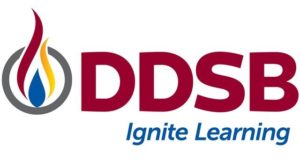
HUE x RMG: Honouring Unapologetic Expression
An exhibition by the Womxn of Colour Durham Collective
HUE x RMG: Honouring Unapologetic Expression is an exhibition of photography by the Womxn of Colour Durham Collective (WOCDC), a youth-led organization in Durham Region that is run by, for, and with Black, Indigenous, and other self-identified Womxn of Colour (BIWoC).
WOCDC aims to create equitable and inclusive spaces to connect and collaborate with BIWoC who may feel marginalized, unsupported, or unheard. Through projects like HUE x RMG, they hope to make lasting change in the community by cultivating spaces where their interests and experiences are given the awareness, recognition and attention they deserve.
Connect. Create. Cultivate.
This exhibition is built around the organization’s three core pillars: connect, create, and cultivate. WOCDC recruited eight racialized womxn and non-binary folks from Durham Region to participate in a photoshoot at the RMG. In small groups, Kezia Amoako, Anna Balagtas, Stephanie Hu, Ashleigh Hutchinson, Reisha Lyon, Melanie McFarlane, Melissa Murray, and Kay Williams were invited to connect with one another and the WOCDC team through storytelling. They had conversations about racism, identity, love, and resistance forged through both positive and negative experiences. Audio from those sessions plays on a loop in the exhibition and excerpts appear on extended labels that accompany the photo installations. Each story is illustrated with a portrait and a snapshot of the urban environment that provides contextual information about the location, theme, or content of participant’s story.
The portraits are visually unified by colourful lights that illuminate the sitters’ face and surroundings. In addition to visualizing the reciprocal relationship between people and place, the treatment of the portraits as a series also reinforces the themes that unfold across the exhibition, including questions of belonging, experiences of prejudice, and celebrations of identity and community. At the same time, the distinct colour gradients bring attention to the essential fact that each participant is unique and not representative of others.
In this exhibition, WOCDC created the conditions for all of the participants to show up without apology. The work brings attention to the joy and beauty of intersectional identities, while expressing the ways racism has affected the participants’ interactions in public spaces. This exhibition is presented as evidence for the infinite potential of spaces made safe for creation and connection in community; you are invited to imagine what could be possible if more spaces were cultivated for BIPOC collaboration in Durham Region and beyond.
The WOCDC and the RMG would like to thank Kezia Amoako, Anna Balagtas, Stephanie Hu, Ashleigh Hutchinson, Reisha Lyon, Melanie McFarlane, Melissa Murray, and Kay Williams for sharing their stories and participating in this project.
We would also like to thank Smokestack for their generous sponsorship of this exhibition.

Follow WOCDC on Instagram! @wocdc & @wocdchue
Mamanaw Pekiskwewina | Mother Tongues: Dish With One Spoon Territory
Curators: Missy LeBlanc, Erin Szikora
Artists: Lacie Burning, Melody Crowe, Jon Colwell, Sabrina Fontaine, Laura Grier, Jay Havens, Mem Ireland, Sarah MacLeod-Beaver, Sheri Osden Nault, Skye Paul, Matthew Stevens, Michael Tiggelman, Dr. Elder Shirley Williams
Mamanaw Pekiskwewina | Mother Tongues: Dish With One Spoon Territory is the second of four locality specific iterations of the Mamanaw Pekiskwewina project and is presented in tandem with the tour of Taskoch pipon kona kah nipa muskoseya, nepin pesim eti pimachihew | Like the winter snow kills the grass, the summer sun revives it, across so-called Canada. Developed in consultation with region-based Elders, Knowledge Keepers, language teachers, and educators, Mamanaw Pekiskwewina: Dish With One Spoon Territory celebrates and makes visible the traditional and ancestral languages of the lands covered by the Dish With One Spoon treaty, an agreement made between the Anishinaabek, Mississauga, and Haudenosaunee Nations to share the resources and responsibilities of the territory. Mamanaw Pekiskwewina: Dish With One Spoon Territory is co-curated by Missy LeBlanc and Erin Szikora for The Robert McLaughlin Gallery.
E-NOKIICHIGAADEK WIINDIMAAGEWIN
Wenesh ediming pii gdoo-zhigiizhiwewin [1] aawizinok ggashi naasaab miiniwaa gnokomisag? Wenesh ediming zhi-giizhiweng nowewin giin debendiziiwon, e-aawzinok nowewin gaa-miigowin miiniwaa ezhi-jiwong giin biinjina, ezhi-mingowin?
E-ninaasaabsek zhiwe nowewining kina mooshin akiin; nowewin zhinoomaagemgwad e-zhi-kendimong gegoo e-kendimong miiniwaa gdi-kinoomaagonaa waa-zhi mindizoying enso-bebezhig miiniwa aki. E-bi-zhi-koginigoong maanda nowewin debendaaksinok, maanda nowewin gaa-mji-miingowewziying gonda sa nji-gaa-bi-digoshnajig, mooshkin mgoshkaajiikemgwad bimaadiziwin miiniwaa giw bimaadiziiwinwaa mshi-ebi-yaasigwaa. Gda-ni-jiibkenwedaanaa miiniwaa dash gda-ni-mnowaangismi biinjina miiniwaa gdi-noweninaa eni-piichi-maajiibdeg kwii-yoomnaang miiniwaa ni-zhinoomaagwiing waa-ni-zhaaying. Wenesh dash e-zhiwebak pii nindan kidwenan eni-zhinoomaagemgok waa-ni-zhaayin bebkaanak kidwenan dash gewiinwaa gaa-zhinoomaagwaad zhaazhi-gaamaajaajig, nindan dash kidwenan mii-na ni-bnaadak nji-sa maanda waabshkiiyewin?
Mamanaw Pekiskwewina Ezhi-gashiwing Deniiwan gii-ntami zhichigaade oodi zaagijeying zhinoomaagewin oodi Calgary Aapitoweying Mzinigan-gamik pii Binaakwe-giizis-Minidoo-giisoonhs 2019. Gii-zhinoomaadim enji-maanjiining nji-sa Taskoch pipon kona kah nipa muskoseya, nepin pesim eti pimachihew Dibishkoo iwa Bibooni-goon e-zhi-nsigemgok miishkoonsan, maaba niibin giizis neyaab bi-maajiigtoon, maanda zhinoomaagewin oodi TRUCK Nongo e-zhinaagok/ Mzinbiigewin pii Baashkaakodin/Minidoo-giisoonsing 2019. Iwi dash aanji-zhinoomaagewin e-zhinikaadek Maamanaw Pekiskwewina gii-biijigaadeg e-maamowi-zijig mesinibiigejig nji-sa niiwing Anishinaabek nowewin enji-baajig zhiwe Treaty 7 nekeyaa – Nakoda, nehiyawewin, Nitsiipowahsiin, miiniwaa Tsuut’ina – wiinwaa gaa maamowi-sidowaad di-nowewinwaa e-zhchigewaad. Maanda dash zinoomaagewin neyaab gii-miinaawag ntam Anishinaabek zhiwe nekeyaa e-yaajig, e-piichi-mshkooziitoowaad maanda doo-a-kiimwaa zhiwe yaa’ing gegoo mooshkin mwijigaadek nowewin mewzha zhichigewinan e-zhi-jiibkenwiying miiniwaa geyaabi bemjiwong biinjina yaa’ing.
Maanda dash bebaa-zhinoomaading Taskoch pipon kona kah nipa muskoseya, nepin pesim eti pimachihew mompii mzowe-kamik Canada e-szhinikaadek, nindan e-zhi-miiksemgak zhinoomaagewinan aabideg gii-aanji-gnowaabnjigaadenoon; gaawii dash go ngoji pkaan zaagigeying zhinoomaagewin, Mamanaw Pekiskwewina gii-daapinigaade ji-aawong nokiiwin waani-zhiseg nendaasowin zhiwe waa-nji-zhinoomaading nindan. Giw waa-zhitoojig maanda da-aabji’aawan Mamanaw Pekiskwewina – e-wiijiiwed Anishinaabe gekendang maanda zhichigan debendaagozid zhiwe – ji-zhichigaadeg maajiishkaawinan nji-sa e-yaajig zhiwe Anishinaabek miiniwaa ji-mina-maajiishkaamgok di-nowewinwaa. Maanda dash ediming “Zhiwe besha” maanda sa nji-maajiishkaawin ngoji pkaan ni-zhaamgod e-zhi-kenjigaadek miiniwaa zhaagonaashii nsastaagewin nikeyaa ooshime e-zhi-gnoonindowaa Anishinaabek debendaagozijig nongo megwaa miiniwaa mewzha gaa-daajig zhiwe akiing monda e-zhidigok megwaa yaawaad.
Maanda dash bezhig naakinigewin nji-sa maanda Mamanaw Pekiskwewina gonda maanda e-miikigig ji-gnoonaawaad Anishinaaben zhiwe endaajig miiniwaa ji-bzindamoowaad nendowendimoowaad ji-yaamowaad asgaabwitaagewin nji-sa ji-naawseg maanda nowewin ezhi-mzinbiigeng. Ezhi-bigosenjigaadeg maanda zhichigewin ji-aansek gbeying naakonigewin zhiwe enji-nokiichigaadeg maanda gonda e-miikigig zhichigan ezhi-aasgaabichigaadek Anishinaabe naadiziwin enokiijig miiniwaa mesnibiigejig gewii go ji-naakmichigaadeg giigidoowin, ezhi-aansek, miiniwaa gbeying nokiitaadiwin nji-sa Anishinaabek debendaagozijig mooshkin e-piichi mina-daabinigaadek gwek nowewin zhichiganan nji-sa akiing.
Mamanaw Pekiskwewina: Naagan Teg Bezhig Emkwaan minik-ekonaabing aawan eko-niizhing niiwin minik aanji-zhichigeng maanda sa Mamanaw Pekiskwewina zhichigan miiniwaa zhinoomaagaade pii zhinoomaading pipon kona, nepin pesim odi mzowe Canada eshnikaadek. Gii-maajiikigaade dibaajimatoodwaa eyaajig getizijig, ge-kendigig gegoo, Anishinaabemowin ekinoomaagejig. Mamanaw Pekiskwewina: Naagan Teg Bezhig Emkwaan minik-ekonaabing aawan mnaajchigaade miiniwaa zhichigaade ji-waabnjigaadek naadiziwin miiniwaa gegeti nowewin nji-sa minik maanda Naagan Teg Bezhig Emkwaan minik-ekonaabing, naakonigewin zhichigan gaa-zhitoojig Anishinaabek Mississauga, miiniwaa Haudenosanee Mzowe ji-maandookiiyaad kina gegoo eteg miiniwaa naadimaadiwin zhinda ekonaabing. Mamanaw Pekiskwewina: Naagan Teg Bezhig Emkwaan minik-ekonaabing gonda Missy LeBlanc miiniwaa Erin Szikora gii-naabsidoon maanda nji-sa Robert McLaughlin Mzinbiiganag enji-gnowenjigaazowaad.
SHKWAAJ NENDIMOOWIN
[1] Maanda memoonji nakaazong ediming “Ezhi-gashiwing Deniiwan” miiniwaa ‘ntam nowewin’ nji-sa iwi nowewin maaba e-ntami-yaad pii-binoojiiwid gaa-kendang miiniwaa geyaabi ezhi-giigdod endaat. Booj dash go, niibina Anishinaabek mzowe mompii akiing dinkaaznaawaa maanda kidwin “ezhi-gashiwing deniiwan” wii-kidwaad edming nowewin njisa wiinwaa gashiwan miinwaa / maage mewzha nowewin. Maanda zhibiigan gnowaabnjigaade iwi ntam gaa-dibaachigaadek zhiwe kidwin “ezhi-gashiwing deniiwan”
PROJECT STATEMENT
What does it mean when your mother tongue [1] is not the language of your mothers and grandmothers? What does it mean to speak in a language that is not your own, that is not the language that has been passed down and flows through you, sustaining you?
Embedded within languages are entire worlds; language reveals how we know what we know and teaches us how to relate to one another and the land. Being raised with a foster language, a language forced onto us by colonizers, affects all aspects of a life and the lives of those that come after. We take root and are nourished within and by our language as it moves through our bodies and guides us. But what happens when the words that guide you are not the same words that guided your ancestors, but are words instead tainted by imperialism and colonialism?
Mamanaw Pekiskwewina | Mother Tongues was first conceived as an offsite exhibition at the Calgary Central Library from October-December 2019. It was presented in concert with Taskoch pipon kona kah nipa muskoseya, nepin pesim eti pimachihew | Like the winter snow kills the grass, the summer sun revives it, an exhibition at TRUCK Contemporary Art in November/December 2019. The original iteration of Mamanaw Pekiskwewina brought together emerging artists from the four Indigenous language groups of the Treaty 7 region—Nakoda, nēhiyawēwin, Nitsiipowahsiin, and Tsuut’ina—who incorporate their ancestral languages into their practice. The exhibition gave space back to the First Nation communities of the area, while asserting that the Indigenous lands that we occupy carry specific language traditions that root us to this land and still flow through us.
For the tour of Taskoch pipon kona kah nipa muskoseya, nepin pesim eti pimachihew across so-called Canada, the relationship between the exhibitions had to be reimagined; rather than a specific offsite exhibition, Mamanaw Pekiskwewina has been adapted to act as a framework of engagement for right relations to the localities of each of the tour locations. Each of the host organizations will utilize the Mamanaw Pekiskwewina—aided by an Indigenous Assistant Curator who has ties to the region—to develop programming that engages with the local Indigenous community and their language revitalization efforts. The definition of ‘local’ for this project has moved away from civic borders and the colonial understanding to one that is more region based and defined in consultation with the Indigenous people that currently and historically reside on the land the host organizations occupy.
One of the main intentions of the Mamanaw Pekiskwewina is for the host organization to engage with the local Indigenous community and be responsive to their needs when it comes to supporting language revitalization efforts through art. The hope is that this engagement will spark long-term institutional change with the host organization by supporting Indigenous cultural workers and artists as well as building a dialogical, reciprocal, and sustainable relationship with the Indigenous community at-large while taking into account the specificity of the language traditions of the land.
Mamanaw Pekiskwewina: Dish With One Spoon Territory is the second of four locality specific iterations of the Mamanaw Pekiskwewina project and is presented in tandem with the tour of pipon kona, nepin pesim across so-called Canada. Developed in consultation with region-based Elders, Knowledge Keepers, language teachers, and educators, Mamanaw Pekiskwewina: Dish With One Spoon Territory celebrates and makes visible the traditional and ancestral languages of the lands covered by the Dish With One Spoon treaty, an agreement made between the Anishinaabek, Mississauga, and Haudenosaunee Nations to share the resources and responsibilities of the territory. Mamanaw Pekiskwewina: Dish With One Spoon Territory is co-curated by Missy LeBlanc and Erin Szikora for The Robert McLaughlin Gallery.
END NOTE
[1] The most common usage of the terms ‘mother tongue’ and ‘first language’ refer to the language that a person first learns during childhood and still speaks at home. However, many Indigenous groups around the world use the term ‘mother tongue’ to refer to the language of their mothers and/or ancestral language. This text observes the latter usage in reference to the phrase ‘mother tongue’.
Conversations on Ezhi-gashiwing Deniiwan
Conversations on Ezhi-gashiwing Deniiwan: Part 1
January 29, 2022 1:00 PM – 2:30 PM
A conversation with Laura Grier, Matthew Stevens, and Melody Crowe, moderated by Erin Szikora.
Conversations on Ezhi-gashiwing Deniiwan: Part 2
February 12, 2022 1:00 PM – 2:30 PM
A conversation with Lacie Burning, Sarah MacLeod-Beaver, and Dr. Elder Shirley Williams, moderated by Missy LeBlanc.
Embedded within languages are entire worldviews. They shape the way we consider ourselves, our environment, and our relationship to those around us. Within so-called Canada there are over 60 distinct Indigenous languages, however, only three are expected to survive the next 100 years—nēhiyawēwin, Anishinaabemowin, and Inuktitut [2]. Despite this dire situation, Indigenous people across this land now known as Canada are taking up the fight to revive and preserve their mother tongues.
Please join us January 29th and February 12th for Conversations on Ezhi-gashiwing Deniiwan, a two-part series exploring the importance of Indigenous languages across Dish With One Spoon Territory. Hear from artists, language teachers, and community organizers who are at the front lines of language revitalization work in our communities.
END NOTE
[2] Gessner, Suzanne and Lorna Wanosts’a7 Williams. Indigenous Languages Recognition, Preservation and Revitalization: A Report on the National Dialogue Session on Indigenous Languages: Abridged Version. Brentwood Bay, BC: First People’s Cultural Council, 2017.
Community-Informed Murals
June 1, 2022 – October 29, 2022
We are pleased to present two community-informed murals by artists Jon Colwell and Jay Havens this summer from June 1st to October 29th at the Delpark and Jess Hann branch libraries. The murals were developed in consultation with local students and Indigenous community members, reflecting the vibrancy and diversity of Oshawa’s Indigenous community, increasing Indigenous visibility and representation in public spaces across the city.
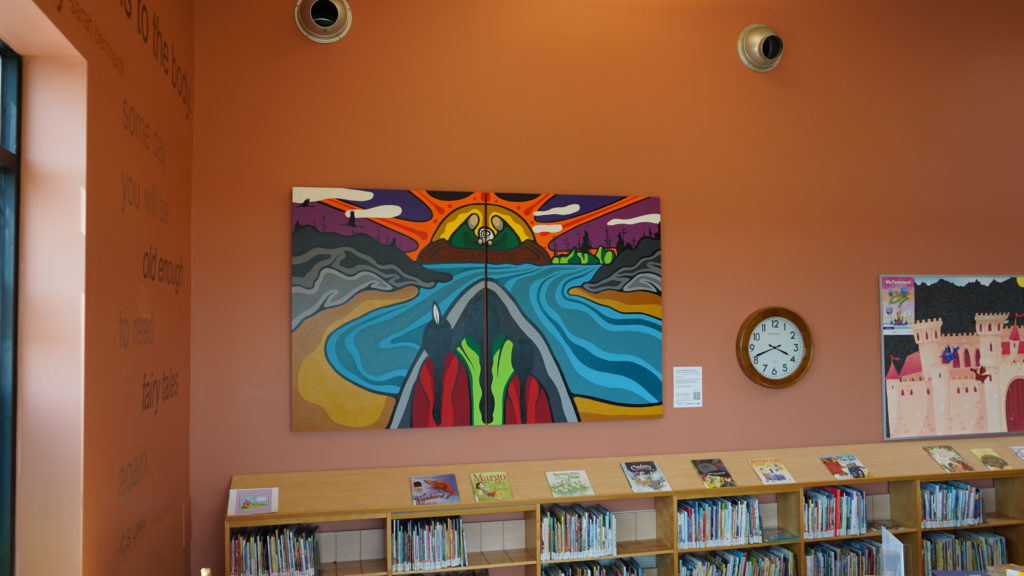
ABOUT THE ARTIST
Jon Colwell is a self-taught painter and digital artist with a lifetime of artistic practice. He resides on Scugog Island and is a proud member of the Missisaugas of Scugog Island First Nation. The main inspirations for his work include street art, graffiti, vinyl toys, punk rock, tattoos, and skateboarding.
This mural was designed in consultation with members of Bawaajigewin Aboriginal Community Circle.
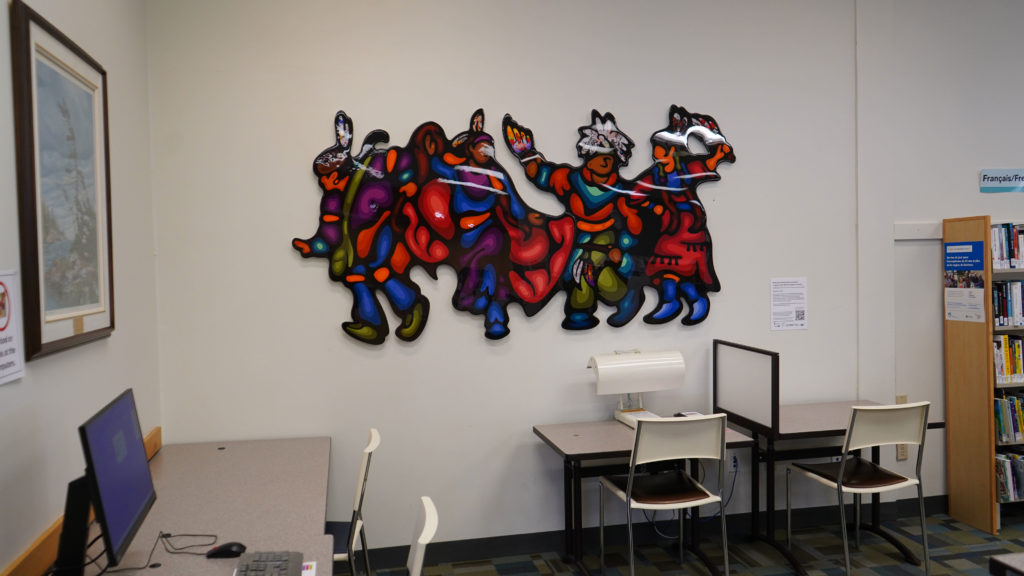
ABOUT THE ARTIST
Jay Havens (he/him/they) is a multi-media 2Spirit artist, educator, and collaborator of Kanien’keha’ka and Scottish Canadian ancestry. Havens was born on Haudenosaunee Territory known as the Haldimand Tract and raised on Unceded Sto:lo and Musqueam lands close to Vancouver, Canada. He is a proud citizen of the Mohawk, Bear Clan from Six Nations of the Grand River.
This mural was designed in consultation with Grade 7-8 students from All Saints Catholic Secondary School. Their drawings can be seen in the feathers of the dancers.
Story and Song: Intro to Anishinaabemowin with Melody Crowe
June 18, 2022 10:30 AM – 11:30 AM
Join us virtually or in-person at Oshawa Public Libraries – Delpark Homes Centre Branch on Saturday, June 18th for a morning of stories and songs with Anishinaabekwe Melody Crowe. Learn the Anishinaabemowin names for the animals living around us. This event is hybrid with limited in-person capacity. To participate in-person, please email Erin Szikora at [email protected]. To participate virtually, please register with the link below. Each participant will receive a printable colouring book. This event is for all ages and is presented in partnership with Oshawa Public Libraries.
We invite you to download a free printable copy of our Story and Song: Anishinaabemowin Colouring Book illustrated by local Indigenous artists Sabrina Fontaine, Mem Ireland, Sheri Osden Nault, Skye Paul, and Michael Tiggelman. Anishinaabemowin translations provided by Melody Crowe.
Mamanaw Pekiskwewina | Mother Tongues: Dish With One Spoon Territory is presented in partnership with TRUCK Contemporary Art.
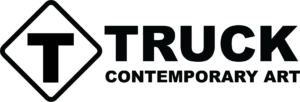
We acknowledge the support of the Canada Council for the Arts and the Ontario Trillium Foundation for this project.


Breaking Down Stereotypes: First Peoples House of Learning (FPHL)
This is an exhibition of posters that combat racist labels and assumptions with positive representations of Indigenous identity. In collaboration with photographer Annie Sakkab, the posters were created by First Peoples House of Learning (FPHL) at Trent University with volunteers from the Indigenous student community.
When pursuing post-secondary education, Indigenous students often face the ongoing impacts of colonization and historical trauma while reclaiming and revitalizing their own cultural identities. In some cases, they may be learning about who they are as Indigenous peoples for the first time. At Trent University, FPHL offers cultural services to a diverse community of Indigenous learners (First Nations Status, Non-Status, Métis and Inuit), providing them with emotional, spiritual, cultural, and physical support as they navigate the university and their personal growth.
In recent years, FPHL recognized that many students struggle with their sense of identity and endure racist treatment from fellow students, professors, and university staff stemming from social and cultural stereotypes. Inspired by the positive impact of a poster series in her own community, Cultural Advisor/Counsellor Betty Carr-Braint set out to confront these harmful misconceptions and create an opportunity for Indigenous students to share their truths. The team at FPHL worked together to bring Breaking Down Stereotypes to life and were excited to launch the project celebrating Indigenous pride and identity at the annual Elders Gathering in 2019. Carr-Braint and the FPHL are very proud of this project and are so happy to be able to share it with communities beyond the campus.
Betty Carr-Braint provides more details about how the project came together:
“This project came together over a couple of years here at Trent University. As the Cultural Advisor/Counsellor at First Peoples House of Learning, I support students who are struggling in a variety of areas; emotionally, spiritually, culturally, physically, and mentally. Through this process we found a shared experience as we realized many of our students were struggling with identity, feeling traumatized by the stereotypical responses from professors, other students, and staff as well. Through no fault of their own Indigenous students were often questioned about their identity, about why they did didn’t know their own history, about why “you people” don’t pay for education or pay taxes and the list of misconceptions and myths goes on. I felt that we needed to educate the broader University about these inappropriate and often racist remarks. I was involved in a poster series in my own community a few years ago and remembered what an impact that had on the women in the community. This was a bit different and yet I felt like we could create something that breaks down these stereotypes. The Team at First Peoples House of Learning (FPHL) was in total support of this idea, and we took the time to bring this one to life. We are so grateful for all the support.
Often, Indigenous students struggle with the on-going impacts of colonization and historical trauma. As a result of the historical attempts to assimilate our nations many students are going through a process of restoring, revitalizing, and reclaiming their own cultural identity, or may even be in the process of learning who they are as Indigenous peoples. At the same time, they are also learning what it means to be a learner at a University where there is often little Indigenous representation.
Throughout the years, we have heard from our students, the hurtful and often racist remarks they hear; comments such as, “you don’t look like an Indian” or “let’s ask her/him, they are native”, thinking Indigenous students are experts on all things native, or “are you sure you are Aboriginal” and the list goes on.
At FPHL, our job is to continually challenge and change these perceptions. We felt it was important to have Indigenous students share the truth about their experiences. We reached out to Indigenous students across Trent University and asked for volunteers to be part of this Poster series that would look at breaking down these stereotypes. We had the Indigenous students choose which stereotype they wanted to address and then we countered the stereotype through photo messaging showing a different view – strong Indigenous students who are proud of who they are. The other point of this series was to show that Indigenous peoples come in all colours, from light skinned to dark skinned and everything in between.
Our Poster series, “Breaking Down Stereotypes”, was launched at the Elders Gathering in 2019 and received amazing acknowledgment. We are working at creating safety for Indigenous students across campus. It is important to acknowledge the courageous students who chose to engage in our poster series and we are so grateful to each of them. Of course, we would be remiss if we did not acknowledge our photographer extraordinaire, Annie Sakkab. Her willingness to support us as we brought this project to life has been so incredible. Her compassion and encouragement helped the students navigate their experiences as they engaged with expressing the stereotypes. Our gratitude for the amazing photos as well as the design and creation of our posters. We are so proud of this project.”
– Betty Carr-Braint
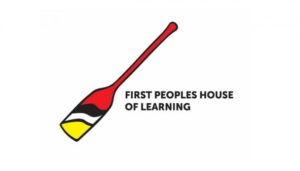

Autism Home Base: Meet Me At The Hub
Created by members of Autism Home Base (AHB), this exhibition brings together a selection of work centered on the theme of connection through shared interests and experiences. ABH is a social network for adults on the autism spectrum, which aims to empower adults with autism and their families to lead rich, active lives, and is committed to providing support and inclusion across the autism spectrum. The self-expression and generous reflection of identity in this exhibition demonstrate the pride and complexity of lived autism experiences. Each work is an opportunity to connect and to build understanding across difference. Taken together, the works illustrate the diversity and beauty of the neurodivergent perspectives that enrich our communities. The exhibition says: what makes us unique also unites us. While stereotypes divide, genuine connection brings us together.
AHB Member Hannah Warner was invited to contribute to this introduction. What follows is her reflection on the project:
“The AHB Hub is a non-judgmental space which facilitates opportunities for discovery, socialization, and recreation, all within a safe and structured environment. This is important because many of us on the spectrum struggle with initiating our own opportunities and/or relationships. At the hub, shared experiences become a foundation for inclusiveness and compassionate expectations. It is a refuge where we can be ourselves without constant reminders that we are different.
Autism is complicated. Every one of us experiences autism differently, but the way others treat us because of it is pretty common. I have felt overwhelmed and isolated in the neurotypical world. However, I still wouldn’t want to be ‘normal.’ Instead, I cherish the beauty and inspiration my autistic brain finds in the world and its ability to recognize the things I am passionate about. Sadly, our interests are often used to alienate us. When it comes to autism, many people see us only as a caricature, assuming our special interests are the only thing there is to know about us. They read our enthusiasm and eagerness to share information as something to avoid. Misrepresenting the experiences that we live for as eccentric obsessions is a stereotype that undermines a great potential for recognizing that humanity is complicated and that there are more similarities than differences between us.
Each member of AHB is multifaceted and multidimensional. Like anyone else, we have interests and hobbies, hopes and fears. Our hearts are just as big as our brains and worth getting to know. Our feelings are visceral and sometimes insuppressible, similar
to your own. Look carefully and I am sure you will find yourself reflected in some way. So please enjoy this exhibit. Find out a little about a stranger; discover a little about yourself.”– Hannah Warner, Member of Autism Home Base
Thank you to all of the AHB members who took part in this exhibition and shared their stories. Our gratitude also goes out to Hailey Yates (art instructor), Rachel Major (program support), and Tristin Haines (blueburnmedia.ca) who edited the art-making video.
Virtual Tour

Psychedelic Oshawa
Psychedelic Oshawa recovers and reimagines a formative period in the city’s cultural awakening during the turbulent years of the 1960s and early 1970s. Contemporary artists from Durham Region and beyond were invited by guest curator Gary Genosko to use historical artefacts as springboards to create new works that bring past events and imagery into focus. These new works are paired with historical reference materials, including photographs, paper ephemera, and obsolete media such as 8-track tapes. Made with hand-knit wool, digital colour illustration, felt, screen printing, paint, yarn, and beeswax, these diverse works pay tribute to a poorly documented era, celebrating its strengths and underappreciated accomplishments.
Gary Genosko is an independent curator and professor at Ontario Tech University in Oshawa.
Participating Artists:
Alison Ariss, textile art historian and knitter
Monique Brent, portraitist and mural painter
Bob Bryden, musician and writer
Betty Carpick, community arts organizer and designer
Scott Cisco, amateur photographer
Desmond Clancy, pen and ink illustrator
Dani Crosby, illustrator and fine arts educator
Gary Gatti, painter and graphic designer
Gary Genosko, independent curator and professor
Hannah Genosko, printmaker and book artist
Len de Graaf, yarn painter and fibre educator
Doug Lewis, curator, videographer, arts educator
Nicole Marhong, painter and sculptor
Christof Migone, curator and sound artist
Martnya Pekala, student of painting
Kai Pinkerton, graphic designer
Thank you to Erin MacKeen, graphic designer and painter, for creating the exhibition logo.
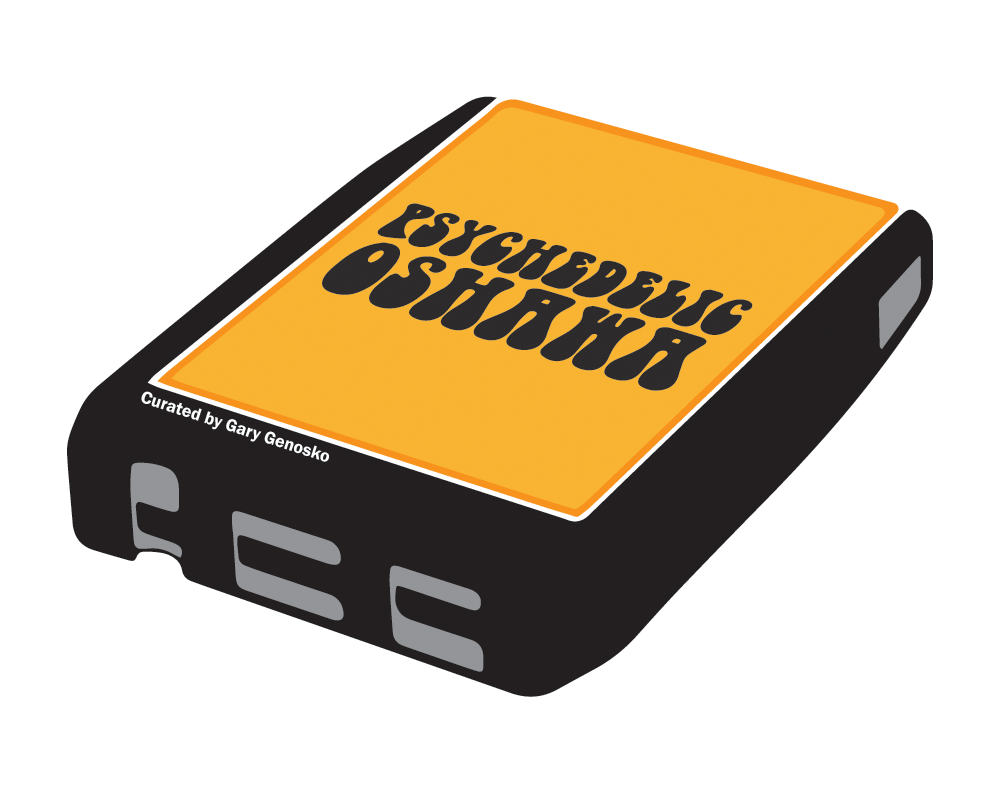
Unmasking Brain Injury
Opening: Thursday, November 22 from 6-9pm
The Brain Injury Association of Durham Region (BIAD) is dedicated to helping individuals and families impacted by brain injuries by connecting community members who share similar physical, emotional, intellectual, spiritual, and social needs.
Members of the association participated in an international movement coordinated by Hinds Feet Farm in Huntsville, North Carolina, to give a face to their injury.
From the months of February to June, members designed masks that reflect their lived experience with a brain injury, with the goal of increasing visibility and awareness around the impact of brain injuries.
The stories shared reveal the challenges that each individual experiences and unmasks what cannot be seen on the outside.
Seniors Art Competition and Exhibition
Opening reception & awards ceremony: Friday, June 15, 3-4:30pm
In partnership with the Oshawa Public Libraries (OPL) and Oshawa Senior Citizens Centres (OSCC), the RMG presents artists, aged 55+, on the occasion of the 10th annual Seniors Art Competition and Exhibition. We are showcasing work that demonstrates the artists’ unique perspectives and reflections regarding the theme of journeys.
The month of June also marks Seniors’ Month and as such, we are celebrating Oshawa’s senior community while engaging the public on a topic that is both meaningful and accessible to all.
Join us on June 15th for the awards ceremony and opening reception where prizes will be presented to the winning artists.
Oshawa Art Association Annual Juried Exhibition
The Oshawa Art Association was established in 1967 and has grown to 250 member artists.
The annual Juried Art Exhibition held at The Robert McLaughlin Gallery attracts talented artists from all over the Durham Region eager to display their art work.
Approximately 80 artists will submit 150 works of art, of which 75 pieces will be selected to hang in the gallery.
Prizes will be awarded to the works which, in the judgement of the jurors, best represent each of the 8 categories ranging from abstract to realism and including a youth category for 12-18 year olds. Jurors for this year’s show are Bianka Guna, Doug Purdon, and Doreen Renner.